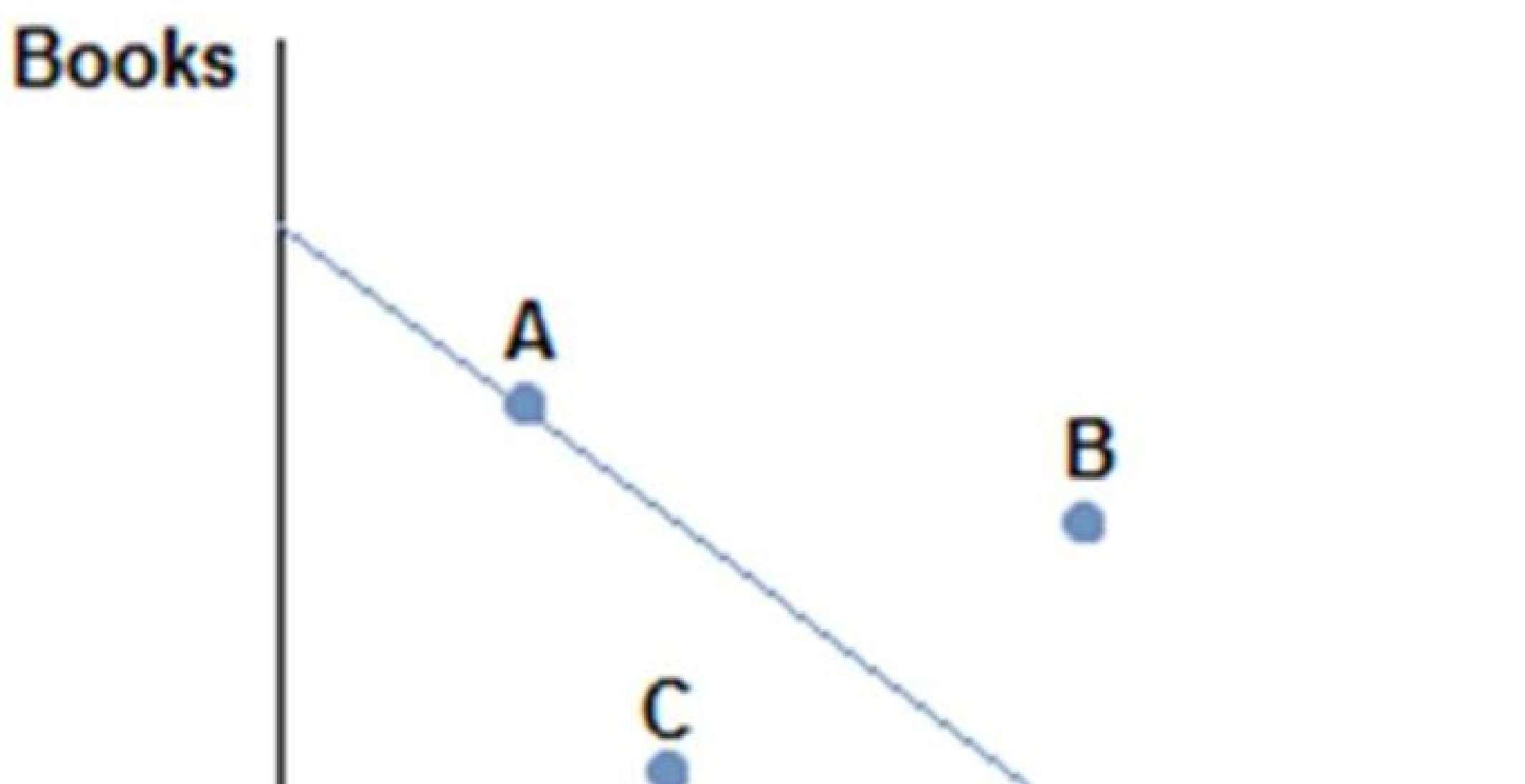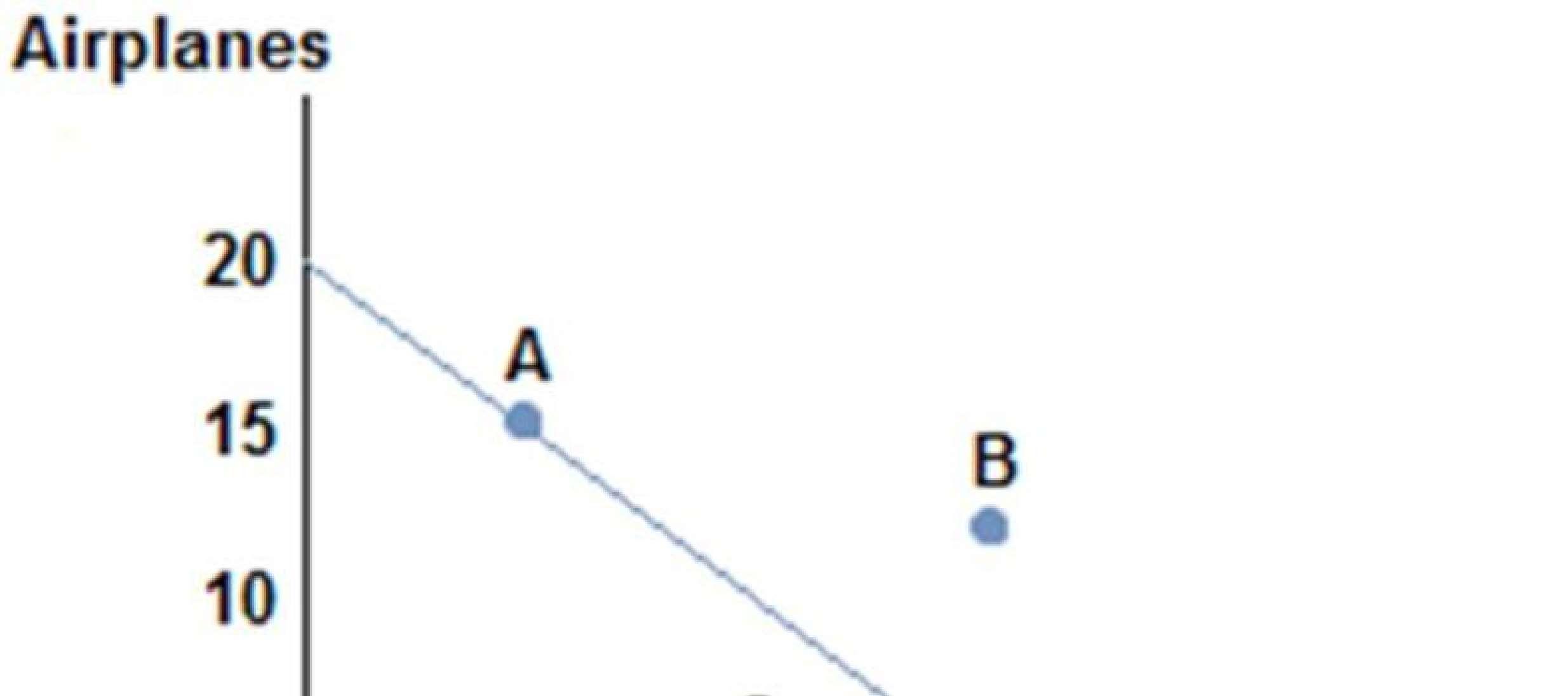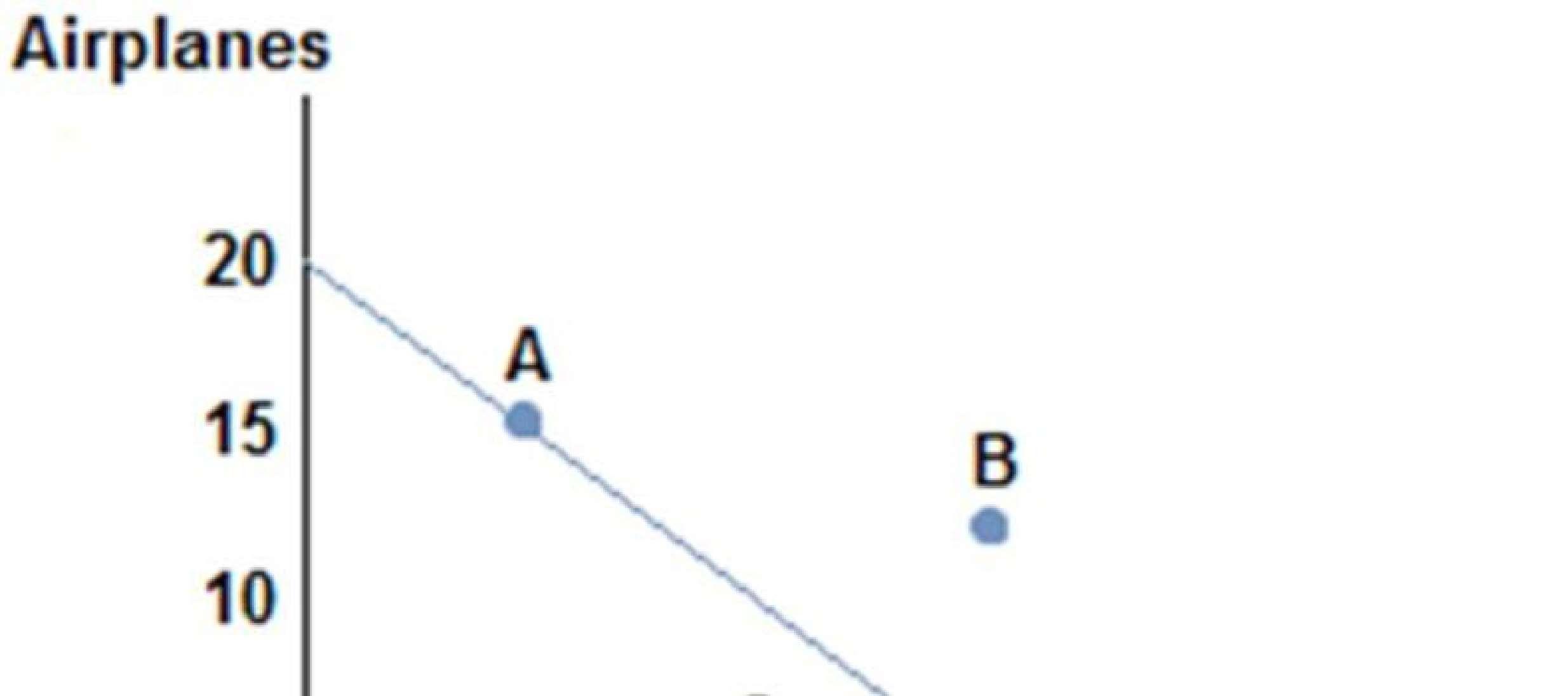MULTIPLE CHOICE. Choose the one alternative that best completes the statement or answers the question.
1) Theinvisiblehandrefersto:
A) thecoordinationthatoccursfromagovernmentagencyfindingefficiencies.
B) thecoordinationthatoccursfromeveryoneworkinginhisorherownself-interest.
C) thecoordinationthatoccursfromagovernmentcoordinatingeconomicactivity.
D) thecoordinationthatoccursfromeveryoneworkingfortheoverallgoodofsociety.
Answer: B
2) Theconceptsofspecializationandgainsfromtradeexplain:
A) internationaltrade.
B) consumerdecisions.
C) whyglobalizationhasexpandedrecently.
D) bothinternationaltradeandthechoicesindividualsmake.
Answer: D
3) Theconceptoftheinvisiblehandwasfirstintroducedtoeconomicsby:
A) DavidRicardo.
C) AdamSmith.
Answer: C
B) ThomasMalthus.
D) MiltonFriedman.
4) Aproductionpossibilitiesfrontierisalineorcurvethat:
A) showsallthepossiblecombinationsofoutputsthatcanbeproducedusingallavailable resources.
B) showsthebestcombinationsofoutputsthatcanbeproducedusingallavailableresources.
C) showswhatcanbeproducedwhenallavailableresourcesarenotefficientlyused.
D) explainswhysocietiesmakethechoicestheydo.
Answer: A
5) Considertheproductionpossibilitiesfrontierdisplayedinthefigureshown.Thefactthatthelineslopes downwarddisplayswhicheconomicconcept?


A) Specialization
C) Productionpossibilities
Answer: D
B) Efficiency
D) Trade-offs
6) Considertheproductionpossibilitiesfrontierdisplayedinthefigureshown.Asocietyfacedwiththiscurve couldchoosetoproduce:


A,D,orC. B) A,B,orC. C) B,C,orD. D) A,B,orD.
Answer: A
7) Considertheproductionpossibilitiesfrontierdisplayedinthefigureshown.Whichpointsareefficientand attainablewithexistingresources?


A) OnlypointA.
C) PointsA,C,andD.
Answer: B
B) PointsAandD.
D) OnlypointB.
8) Considertheproductionpossibilitiesfrontierdisplayedinthefigureshown.Asocietyfacedwiththiscurve:


A) canonlyobtainpointC.
C) cannotobtainpointC.
Answer: D
B) canonlyobtainpointDorpointA.
D) cannotobtainpointB.
9) Considertheproductionpossibilitiesfrontierdisplayedinthefigureshown.Whichofthefollowing statementsistrue?


A) ProducingatpointDwouldbe inefficient.
C) ProducingatpointBwouldbe inefficient.
Answer: D
B) ProducingatpointAwouldbe inefficient.
D) ProducingatpointCwouldbe inefficient.
10) Considertheproductionpossibilitiesfrontierdisplayedinthefigureshown.Whichofthefollowing statementsistrue?


A) ProducingatpointAisthebestchoice,becausesomeofbothitemsaremade.
B) ProducingatpointBisimpossible.
C) ProducingatpointDwouldbeinefficient,sincenobookswouldbeproduced.
D) ProducingatpointCisthebestchoice,becauseit'sclosesttothemiddle.
Answer: B
11) Theslopeofaproductionpossibilitiesfrontiermeasures:
A) howmuchofonegoodthatmustbegivenupinordertoproduceoneoftheothergood.
B) thetrade-offinherentintheproductionofonegoodversustheothergood.
C) theopportunitycostofproducingonegoodintermsoftheothergood.
D) Allofthesestatementsaretrue.
Answer: D
12) Considertheproductionpossibilitiesfrontierdisplayedinthefigureshown.Asocietywillchooseto produce:


A) atpointDbecauseitrepresentsthemostapplesthesocietycanproduce.
B) atpointCbecauseitisthesafest.
C) atpointAbecauseitisalwaysbesttoproducesomeofeachgood.
D) Noneofthesestatementsarenecessarilytrue.
Answer: D
13) Considertheproductionpossibilitiesfrontierdisplayedinthefigureshown.Theopportunitycostofabushel ofapplesis:


A) 1/40watermelons.
C) 3/20watermelons.
Answer: D
B) 1/30watermelons.
D) 1/20watermelons.
14) Considertheproductionpossibilitiesfrontierdisplayedinthefigureshown.Theopportunitycostofone watermelonis:


A) 30bushelsofapples.
C) 10bushelsofapples.
Answer: B
B) 20bushelsofapples.
D) 40bushelsofapples.
15) Considertheproductionpossibilitiesfrontierdisplayedinthefigureshown.Ifthissocietychoosesto produce200bushelsofapples:


A) itcanproducenomorethan10watermelons.
B) itcanproducenomorethan20watermelons.
C) itcanproducenomorethan15watermelons.
D) itcanproducenomorethan5watermelons.
Answer: A
16) Considertheproductionpossibilitiesfrontierdisplayedinthefigureshown.Whichofthefollowing combinationscouldbeproduced?


A) (20watermelons,400bushelsofapples) B) (10watermelons,400bushelsofapples) C) (10watermelons,300bushelsofapples) D) (15watermelons,100bushelsofapples)
Answer: D
17) Considertheproductionpossibilitiesfrontierdisplayedinthefigureshown.Whichofthe followingcombinationscould notbeproduced?


A) (15watermelons,100bushelsofapples)
C) (20watermelons,400bushelsofapples)
Answer: C
B) (10watermelons,150bushelsofapples)
D) (0watermelons,400bushelsofapples)
18) Considertheproductionpossibilitiesfrontierdisplayedinthefigureshown.Ifthissocietychoosesto produce15watermelons:


A) itcanproducenomorethan300bushelsofapples.
B) itcanproducenomorethan200bushelsofapples.
C) itcanproducenomorethan100bushelsofapples.
D) itcanproducenomorethan400bushelsofapples.
Answer: C
19) Considertheproductionpossibilitiesfrontierdisplayedinthefigureshown.Whichofthefollowing statementsistrue?


A) Theopportunitycostofonewatermelonisconstant.
B) Theopportunitycostofonewatermelonwillincreaseasmorewatermelonsareproduced.
C) TheopportunitycostofonewatermelonisverylowatpointC.
D) Theopportunitycostofonewatermelonwilldecreaseasmorewatermelonsareproduced.
Answer: A
20) Ifweconsidertherealitythateachworkerhasdifferentskills,thentheproductionpossibilities frontier:
A) wouldhaveaconvexshape. B) wouldbeastraightline.
C) wouldhaveaconcaveshape. D) wouldshiftoutward.
Answer: C
21) Ifweconsidertherealitythateachworkerhasdifferentskills,thentheproductionpossibilities frontier:
A) woulddisplayadecreasingopportunitycostofagoodasmoreofthatgoodisproduced.
B) woulddisplayanincreasingopportunitycostofagoodasmoreofthatgoodisproduced.
C) woulddisplayaconstantopportunitycostofagoodasmoreofthatgoodisproduced.
D) cannotbedrawn,astoomanyvariableswouldneedtobetakenintoconsideration.
Answer: B
22) Arealisticproductionpossibilitiescurve:
A) ismoreconcavethanoneassumingconstantopportunitycosts.
B) isstraighterthanoneassumingconstantopportunitycosts.
C) ismoreconvexthanoneassumingconstantopportunitycosts.
D) ismoreconcavethanoneassumingincreasingopportunitycosts.
Answer: D
23) Considertheproductionpossibilitiesfrontierinthefigureshown.Asmoreandmorecarsareproduced:


A) theopportunitycostofcarsstaysthesame.
B) theopportunitycostofcarsdecreasesthenincreases.
C) theopportunitycostofcarsincreases.
D) theopportunitycostofcarsdecreases.
Answer: C
24) Considertheproductionpossibilitiesfrontierinthefigureshown.Asmoreandmorecigarsareproduced:


A) theopportunitycostofcarsdecreasesthenincreases.
B) theopportunitycostofcarsdecreases.
C) theopportunitycostofcarsincreases.
D) theopportunitycostofcarsstaysthesame.
Answer: B
25) Considertheproductionpossibilitiesfrontierinthefigureshown.Theopportunitycostofmovingfrompoint AtopointB:


A) is10carspercigar.
B) is10cigarspercar. C) is5cigarspercar.
D) is5carspercigar.
Answer: C
26) Considertheproductionpossibilitiesfrontierinthefigureshown.Theopportunitycostofcarswhenmoving frompointBtopointC:


A) isgreaterthantheopportunitycostofcarswhenmovingfrompointAtopointB.
B) isgreaterthantheopportunitycostofcarswhenmovingbetweenanyothertwopoints.
C) islessthantheopportunitycostofcarswhenmovingfrompointAtopointB.
D) Noneofthesestatementsaretrue.
Answer: A
27) Choosingtoproduceatanypointwithinaproductionpossibilitiesfrontier:
A) isefficient,meaningthesocietywouldbeusingallitsavailableresourcesintheirbest possibleuses.
B) isefficient,meaningthesocietywouldbeusingallitsavailableresources,thoughnotintheir bestuses.
C) isinefficient,meaningthesocietywouldnotbeusingallitsavailableresourcesintheirbest possibleuses.
D) isunobtainable,meaningthesocietycannotproducethatcombinationofgoods.
Answer: C
28) Theproductionpossibilitiesfrontier:
A) cannotshowallpossiblecombinationsofgoodsbecausesocietyistypicallyinefficient.
B) canshowuswhichpossiblecombinationsofgoodssocietyshouldchoose,butcannottellus whichpointswillbeinefficient.
C) canshowallpossiblecombinationsofgoodsbutnottelluswhichcombinationsociety shouldchoose.
D) canshowallpossiblecombinationsofgoodsandwhichsocietyshouldchoose.
Answer: C
29) Ifsocietyweretoexperienceanincreaseinitsavailableresources:
A) itsproductionpossibilitiesfrontierwouldshiftin.
B) itsproductionpossibilitiesfrontierwouldbecomeconvex.
C) itsproductionpossibilitiesfrontierwouldshiftout.
D) itsproductionpossibilitiesfrontierwouldnotmove,butsocietycouldchangeitsproduction choice.
Answer: C
30) Considerasocietyfacingtheproductionpossibilitiescurvesinthefigureshown.Whatisthemost likelycauseofasocietymovingfromPPF1 toPPF2?


A) Adesiretoreadmorebooks
C) Moreworkers
Answer: D
B) Bettersewingtechnology
D) Betterprintingpresstechnology
31) Considerasocietyfacingtheproductionpossibilitiescurvesinthefigureshown.Whatisthemost likelycauseofasocietymovingfromPPF1 toPPF3?


A) Moreworkers
C) Bettersewingtechnology
Answer: A
B) Betterprintingpresstechnology
D) Adesiretoreadmorebooks
32) Considerasocietyfacingtheproductionpossibilitiescurvesinthefigureshown.Whatisthemost likelycauseofasocietymovingfromPPF3 toPPF1?


A) Moreworkers
C) Adesiretoreadmorebooks
Answer: B
B) Atornado
D) Bettersewingtechnology
33) Anincreaseinproductivityasaresultofanewtechnologywouldcausetheproduction possibilitiesfrontierto:
A) shiftin.
B) becomemoremeaningfulinpolicydecisions.
C) notmoveuntilsocietychoosestomoveit.
D) shiftout.
Answer: D
34) HurricaneKatrinadestroyedmuchofNewOrleansandotherpartsoftheSouth.Whichofthe followingstatementsistrue?
A) ThehurricanecausedNewOrleans'productionpossibilitiestoincrease,sinceitcreatedalot ofworktorebuildthecityandsurroundingareas.
B) ThehurricanecausedNewOrleans'productionpossibilitiesfrontiertoshiftoutwards.
C) ThehurricanecausedNewOrleans'productionpossibilitiestoshiftinwards.
D) Noneofthesestatementsaretrue.
Answer: C
35) Trade:
A) increasestotalproduction,whichbenefitsonlythemorewealthynation.
B) decreasestotalproductionacrossnationsbutincreasesitforsome.
C) increasestotalproduction,whichcanbenefiteveryoneinvolved.
D) decreasestotalproductionacrossnationsbutbenefitseveryonebecausetheyareindividually moreproductive.
Answer: C
36) Trade:
A) canbenefiteveryoneinvolved.
B) canonlybenefitonepartyofthetrade,butwecannotsaywhichwithoutmoreinformation.
C) onlybenefitsthestrongernation.
D) onlybenefitstheweakernation.
Answer: A
37) Trade:
A) oftenhurtsbothpartiesinthelongrun. B) canbenefitbothparties.
C) isazerosumproposition.
Answer: B
D) involvesawinnerandaloser.
38) IfawealthynationsuchasCanadatradeswithapoorer,lessdevelopednationlikeCambodia, thenitislikelytruethat:
A) bothCanadaandCambodiacanbenefitfromtrading.
B) Cambodiaispressuredtoentertradeandnotbenefitingatall.
C) Canadaisbeingcharitableandnotbenefitingfromthetradeatall.
D) CanadaistakingadvantageofCambodiaandistheonlybeneficiarytothetrade.
Answer: A
39) Supposethat,giventhesamenumberofworkers,Canadacanproducefivetimesasmany computersor10timesasmanyairplanesasMexico.Whichofthefollowingstatementsistrue?
A) Canadahasanabsoluteadvantageintheproductionofairplanes,andMexicohasanabsolute advantageintheproductionofcomputers.
B) Canadahasanabsoluteadvantageintheproductionofbothairplanesandcomputers.
C) Mexicohasanabsoluteadvantageintheproductionofbothairplanesandcomputers.
D) Canadahasanabsoluteadvantageintheproductionofcomputers,andMexicohasan absoluteadvantageintheproductionofairplanes.
Answer: B
40) Supposethat,giventhesamenumberofworkers,CanadacanproducetwotimesasmanyTVsor 20timesasmanypotatoesasChile.Whichofthefollowingstatementsistrue?
A) ChileshouldtradewithCanadaforpotatoesbecauseCanadahasanabsoluteadvantagein theproductionofpotatoes.
B) CanadacanbenefitfromtradingTVsbutnotpotatoeswithChile.
C) ChileshouldtradewithCanadaforTVsbecauseCanadahasanabsoluteadvantageinthe productionofpotatoes.
D) Noneofthesestatementsisnecessarilytrue.
Answer: D
41) Ifacountrypossessestheabsoluteadvantageintheproductionofonegood:
A) itcanproducemoreofthatgoodgiventhesameresources.
B) thenitmustalsopossessthecomparativeadvantageintheproductionofthatgood.
C) thenitmustalsopossesstheabsoluteadvantageintheproductionoftheothergood.
D) thenitmustalsopossessthecomparativeadvantageintheproductionoftheothergood.
Answer: A
42) Supposethatonlytwogoodsareproducedinaneconomy.Ifacountrypossessesthecomparative advantageintheproductionofonegood:
A) thenitcannotalsopossesstheabsoluteadvantageintheproductionofthatgood.
B) thenitmustalsopossesstheabsoluteadvantageintheproductionofthatgood.
C) thenitcannotalsopossessthecomparativeadvantageintheproductionoftheothergood.
D) thenitmustalsopossessthecomparativeadvantageintheproductionoftheothergood.
Answer: C
43) SupposeaCanadianworkercanmake20pairsofshoesorgrow100applesperday.AnAmerican worker,ontheotherhand,canproduce10pairsofshoesorgrow20applesperday.Whichofthe followingstatementsistrue?
A) CanadahastheabsoluteadvantageintheproductionofshoesandtheU.S.hastheabsolute advantageintheproductionofapples.
B) Canadahastheabsoluteadvantageintheproductionofbothshoesandapples.
C) TheU.S.hastheabsoluteadvantageintheproductionofshoesandCanadahastheabsolute advantageintheproductionofapples.
D) TheU.S.hastheabsoluteadvantageintheproductionofbothshoesandapples.
Answer: B
44) SupposeaCanadianworkercanmake20pairsofshoesorgrow100applesperday.AnAmerican worker,ontheotherhand,canproduce10pairsofshoesorgrow20applesperday.Whichofthe followingstatementsistrue?
A) Canadahasanabsoluteadvantageintheproductionofbothgoodsandacomparative advantageintheproductionofneithergood.
B) Canadahasanabsoluteadvantageandacomparativeadvantageintheproductionofapples.
C) Canadahasanabsoluteadvantageintheproductionofbothgoodsandacomparative advantageintheproductionofbothgoods.
D) Canadahasanabsoluteadvantageandacomparativeadvantageintheproductionofshoes.
Answer: B
45) SupposeaCanadianworkercanmake20pairsofshoesorgrow100applesperday.AnAmerican worker,ontheotherhand,canproduce10pairsofshoesorgrow20applesperday.Whichofthe followingstatementsistrue?
A) Canadahasacomparativeadvantageintheproductionofshoes.
B) Bothcountrieshaveacomparativeadvantageintheproductionofshoes.
C) TheU.S.hasacomparativeadvantageintheproductionofshoes.
D) Comparativeadvantagedoesn'texistinthisscenario.
Answer: C
46) SupposeaCanadianworkercanmake20pairsofshoesorgrow100applesperday.AnAmerican worker,ontheotherhand,canproduce10pairsofshoesorgrow20applesperday.Canada should:
A) produceapples,sincetheyhaveacomparativeadvantageintheproductionofapples,and tradeforshoes.
B) producebothgoods,sincetheyhaveanabsoluteadvantageinbothgoods,andnottrade.
C) produceapples,sincetheyhaveacomparativeadvantageintheproductionofapples,andnot trade.
D) produceonlyshoes,sincetheyhaveacomparativeadvantageintheproductionofshoes,and nottrade.
Answer: A
47) SupposeaCanadianworkercanmake20pairsofshoesorgrow100applesperday.AnAmerican worker,ontheotherhand,canproduce10pairsofshoesorgrow20applesperday.The opportunitycostofonepairofshoesforCanadais________,whiletheopportunitycostofone pairofshoesfortheU.S.is________.
A) 1/5 apple;½apple
C) 5apples;2apples
Answer: C
B) 2,000apples;200apples
D) 100apples;20apples
48) SupposeaCanadianworkercanmake20pairsofshoesorgrow100applesperday.AnAmerican worker,ontheotherhand,canproduce10pairsofshoesorgrow20applesperday.The opportunitycostforCanadais:
A) 1pairofshoesforevery2apples. B) 5pairsofshoesforeachapple.
C) 5applesforeachpairofshoes. D) 1/5 appleforeachpairofshoes.
Answer: C
49) SupposeaCanadianworkercanmake20pairsofshoesorgrow100applesperday.AnAmerican worker,ontheotherhand,canproduce10pairsofshoesorgrow20applesperday.The opportunitycostfortheU.S.is:
A) ½appleforeachpairofshoes. B) ½pairofshoesforevery2apples.
C) 2applesforeachpairofshoes. D) 2pairsofshoesforeachapple.
Answer: C
50) SupposeaCanadianworkercanmake20pairsofshoesorgrow100applesperday.AnAmerican worker,ontheotherhand,canproduce10pairsofshoesorgrow20applesperday.The opportunitycostofapairofshoesis________forCanadathantheU.S.,sotheU.S.hasthe ________advantageinshoeproduction.
A) higher;comparative B) lower;comparative
C) lower;absolute D) higher;absolute
Answer: A
51) SupposeaCanadianworkercanmake20pairsofshoesorgrow100applesperday.AnAmerican worker,ontheotherhand,canproduce10pairsofshoesorgrow20applesperday.TheU.S.has the________opportunitycostofapairofshoesthanCanada,so:________.
A) lower;theU.S.shouldspecializeinshoeproduction
B) higher;theU.S.shouldspecializeinappleproduction
C) higher;theU.S.shouldspecializeinshoeproduction
D) lower;theU.S.shouldspecializeinappleproduction
Answer: A
52) SupposeaCanadianworkercanmake50pairsofglovesorgrow300radishesperday.A Bangladeshiworker,ontheotherhand,canproduce100pairsofglovesorgrow200radishesper day.Theopportunitycostofonepairofglovesis:
A) 6,000radishesforCanadaand2,000radishesforBangladesh.
B) 1/6radishesforCanadaand½radishesforBangladesh.
C) 60radishesforCanadaand20radishesforBangladesh.
D) 6radishesforCanadaand2radishesforBangladesh.
Answer: D
53) SupposeaCanadianworkercanmake50pairsofglovesorgrow300radishesperday.A Bangladeshiworker,ontheotherhand,canproduce100pairsofglovesorgrow200radishesper day.Usingtheconceptofabsoluteadvantage,whichofthefollowingstatementsistrue?
A) Canadahastheabsoluteadvantageintheproductionofgloves,butnotradishes.
B) Canadahastheabsoluteadvantageintheproductionofbothglovesandradishes.
C) Canadahastheabsoluteadvantageintheproductionofradishes,butnotgloves.
D) Canadadoesnothavetheabsoluteadvantageintheproductionofeitherglovesorradishes.
Answer: C
54) SupposeaCanadianworkercanmake50pairsofglovesorgrow300radishesperday.A Bangladeshiworker,ontheotherhand,canproduce100pairsofglovesorgrow200radishesper day.Usingtheconceptsofabsoluteandcomparativeadvantage,wecansaythat:
A) Canadahasthecomparativeadvantageintheproductionofbothglovesandradishes.
B) Canadahasthecomparativeadvantageintheproductionofradishesonly.
C) Canadahasthecomparativeadvantageinneithertheproductionofglovesnorradishes.
D) Canadahasthecomparativeadvantageintheproductionofglovesonly.
Answer: B
55) SupposeaCanadianworkercanmake50pairsofglovesorgrow300radishesperday.A Bangladeshiworker,ontheotherhand,canproduce100pairsofglovesorgrow200radishesper day.Usingtheconceptsofadvantageandtrade,wecansaythat:
A) theopportunitycostofonepairofglovesisthesameforbothCanadaandBangladesh, thereforenocomparativeadvantageexists.
B) theopportunitycostofonepairofglovesislowerforCanadathanBangladesh,therefore Canadahasacomparativeadvantageingloveproduction.
C) theopportunitycostofonepairofglovesishigherforCanadathanBangladesh,therefore Canadahasacomparativeadvantageinradishproduction.
D) theopportunitycostofonepairofglovesisthesameforbothCanadaandBangladesh, thereforetheybothhavethecomparativeadvantageingloveproduction.
Answer: C
56) SupposeaCanadianworkercanmake50pairsofglovesorgrow300radishesperday.A Bangladeshiworker,ontheotherhand,canproduce100pairsofglovesorgrow200radishesper day.Whichofthefollowingstatementsistrue?
A) Bangladeshshouldspecializeingloveproductionsinceitpossessesthecomparative advantageingloveproduction.
B) Bangladeshshouldonlyproduceradishessinceithastheabsoluteadvantageinradish production.
C) Bangladeshshouldonlyproduceglovessinceithastheabsoluteadvantageinglove production.
D) Bangladeshshouldspecializeinradishproductionsinceitpossessesthecomparative advantageinradishproduction.
Answer: A
57) SupposeaCanadianworkercanmake100chairsorcatch1,000fishperday.AChileanworker, ontheotherhand,canproduce40chairsorcatch400fishperday.Whichofthefollowing statementsistrue?
A) Chilehasthecomparativeadvantageinchairproduction.
B) Canadahasthecomparativeadvantageinchairproduction.
C) BothCanadaandChilehaveacomparativeadvantageinchairproduction.
D) NeitherCanadanorChilehasacomparativeadvantageinchairproduction.
Answer: D
58) SupposeaCanadianworkercanmake100chairsorcatch1000fishperday.AChileanworker, ontheotherhand,canproduce40chairsorcatch400fishperday.Canadapossessesa(n) ________advantageinchairproduction,but nota(n)________advantageinfishproduction.
A) absolute;comparative
C) comparative;comparative
Answer: A
B) absolute;absolute
D) comparative;absolute
59) SupposeaCanadianworkercanmake100chairsorcatch900fishperday.AChileanworker,on theotherhand,canmake40chairsorcatch400fishperday.Canadahasanabsoluteadvantagein theproductionofbothfishandchairs.Thismeansthat:
A) CanadashouldproducebothgoodsandnottradewithChile.
B) CanadashouldtakeadvantageofChilebytradingwiththem.
C) CanadashouldproduceonlyfishandtradewithChiletogetchairs.
D) CanadacanproducemorefishandchairsthanChilegiventhesameamountofworkers.
Answer: D
60) Whenaproducerhastheabilitytoproduceagoodorserviceataloweropportunitycostthan others,economistssaytheproducer:
A) hasnoreasontotradewithothers.
B) hasacomparativeadvantageatproducingthatgood.
C) hasanabsoluteadvantageatproducingthatgood.
D) isefficient.
Answer: B
61) Whenaproducerhasacomparativeadvantageinproducingagood,itmeanstheproducer:
A) hasnoreasontotradewithothers.
B) canproducemoreofthatgoodthanotherswiththesamenumberofworkers.
C) hastheabilitytoproducethegoodataloweropportunitycostthanothers.
D) isefficient.
Answer: C
62) Whenaproducerhasanabsoluteadvantageatproducingagood,itmeanstheproducer:
A) canproducemoreofthatgoodthanotherswiththesamenumberofworkers.
B) hastheabilitytoproduceagoodorserviceataloweropportunitycostthanothers.
C) islessefficientthanotherproducers.
D) hasnoreasontotradewithothers.
Answer: A
63) Whenaproducerisactingefficiently:
A) itisproducingatapointonitsproductionpossibilitiesfrontier.
B) itisproducingonlyonegood.
C) itisproducingthegoodinwhichithasanabsoluteadvantage.
D) itisproducingatapointonorunderitsproductionpossibilitiesfrontier.
Answer: A
64) Whenacountryisactingefficiently:
A) itisabletoreachapointbeyonditsproductionpossibilitiesfrontier.
B) ithasunemployedworkers.
C) itisproducingatapointonorbelowitsproductionpossibilitiesfrontier.
D) itisgettingthemostoutputbyusingallitsavailableresources.
Answer: D
65) CanadaandtheU.S.tradehockeyskatesandapplepie.IfCanadahasanabsoluteanda comparativeadvantageintheproductionofapplepie,then:
A) TheU.S.musthavethecomparativeadvantageintheproductionofskates.
B) TheU.S.musthavetheabsoluteandcomparativeadvantageintheproductionofskates.
C) Canadamusthavethecomparativeadvantageintheproductionofskates,too.
D) TheU.S.musthavetheabsoluteadvantageintheproductionofskates.
Answer: A
66) Whichofthefollowingstatementsaboutabsoluteandcomparativeadvantageistrue?
A) Acountrymayhaveanabsoluteadvantagebutnotacomparativeadvantageinthe productionofagood
B) Acountrymayhaveacomparativeadvantagebutnotanabsoluteadvantageinthe productionofagood.
C) Acountrymayhavetheabsoluteadvantageintheproductionofallgoods.
D) Allofthesestatementsaretrue.
Answer: D
67) Acountrythatspecializes:
A) spendsallofitsresourcesproducingonlywhatothercountriesneed.
B) spendsallofitsresourcesproducingaparticulargood.
C) spendsallofitsresourcesproducingwhatitcanmakemoreofthananyoneelse.
D) spendsallofitsresourcesproducingthosegoodsithasanabsoluteadvantageinproducing.
Answer: B
68) Whentwocountriesspecializeandtradewithoneanother:
A) totalproductionandconsumptionremainunchanged.
B) totalproductionremainsunchangedbutconsumptionrises.
C) totalproductionincreases,butonlyifcomparativeadvantageexists.
D) totalproductionmayincrease,dependingontraderelations.
Answer: C
69) Peoplechoosetospecializebecause:
A) itcanleadtomoreconsumptionthanbeingself-sufficient.
B) itallowspeopletoacquiregoodsataloweropportunitycost.
C) itcanleadtoconsumptionbeyondtheproductionpossibilitiesfrontier.
D) Allofthesestatementsaretrue.
Answer: D
70) Theimprovementinoutcomesthatoccurswhenspecializedproducersexchangegoodsand servicesiscalled:
A) thegainsfromtrade.
C) absoluteadvantage.
Answer: A
71) Peoplewillchoosetospecializeandtradeif:
B) comparativeadvantage.
D) specialization.
A) theycanacquirethegoodstheywantatahighercostthanitwouldcostthemtomakethe goodsthemselves.
B) theycanacquirethegoodstheywantfromacapitalisticsystemofexchange.
C) theycanacquirethegoodstheywantatalowercostthanitwouldcostthemtomakethe goodsthemselves.
D) theycanacquirethegoodstheywantfromsomeonewhoiswillingtotradewiththem.
Answer: C
72) Peopleoftenchoosetospecializeandtradebecause:
A) itallowsthemtogettoapointbeyondtheirownproductionpossibilitiesfrontier.
B) theycanconsumeabundleofgoodsbeyondtheirownproductionpossibilities.
C) itallowsthemtoenjoymoregoodsthantheycancreateontheirown.
D) Allofthesestatementsaretrue.
Answer: D
73) Twocountrieswillchoosetospecializeandtradeonlyif:
A) theopportunitycostsareastronomicallyhighforproducingthegoodsontheirown.
B) onecountrypossessestheabsoluteadvantageinbothgoods,butthecomparativeadvantage inonlyonegood.
C) theopportunitycostsarethesameforthetwonations.
D) thetermsoftradefallbetweentheiropportunitycostsforproducingthegoodsontheirown.
Answer: D
74) Whenacountrylosesitscomparativeadvantageintheproductionofagood:
A) itwillgainthecomparativeadvantageintheproductionofanothergood.
B) itshouldstoptradingandbecomeself-sufficient.
C) itwillbecomealoserintradeinthelongrun.
D) itwillstillhavetheabsoluteadvantageintheproductionofthegood.
Answer: A
75) IfFranceiscapableofproducingeithercheeseorwineorsomecombinationofthosetwo products,then:
A) Franceshouldproducetheoneforwhichithasahigheropportunitycost.
B) Franceshouldremainself-sufficientifithastheabsoluteadvantageintheproductionof both.
C) Franceshouldproducetheoneforwhichithasacomparativeadvantage.
D) Franceshouldproducetheoneitismoreefficientatproducing.
Answer: C
76) IfSpainiscapableofproducingeithertapasorsoccerballsorsomecombinationofthosetwo products,then:
A) Spainshouldremainself-sufficientifitcanproducebothefficiently.
B) Spainshouldtradeonlyifitpossessestheabsoluteadvantageintheproductionofboth goods.
C) Spainshouldproducethegoodithasacomparativeadvantageinproducing.
D) Spainshouldproducethegoodithasanabsoluteadvantageinproducing.
Answer: C
77) AssumethattheopportunitycostforGermanytoproduceajetis50cars.Somepossible combinationsofoutputforGermanycouldbe:
A) (2,500jets,2,000cars)and(2,300jets,20,000cars).
B) (1,000jets,5,000cars)and(900jets,10,000cars).
C) (1,000jets,5,000cars)and(900jets,15,000cars).
D) (2,500jets,2,000cars)and(2,300jets,3,000cars).
Answer: B
78) SupposethefigureshownrepresentstheproductionpossibilitiesfrontierforCountryA.CountryBoffersto tradefourtrucksforeveryairplane.AssumingCountryAspecializesinairplaneproduction,whichofthe followingcombinationsofgoodscouldCountryAconsume?


A) (15airplanes,20trucks)
C) (10airplanes,30trucks)
Answer: A
B) (5airplanes,20trucks)
D) (10airplanes,20trucks)
79) SupposethefigureshownrepresentstheproductionpossibilitiesfrontierforCountryA.Whichofthe followingcombinationsofgoodscouldCountryAconsumeintheabsenceoftrade?


A) (10airplanes,25trucks)
C) (10airplanes,30trucks)
Answer: B
B) (5airplanes,30trucks)
D) (15airplanes,15trucks)
80) SupposeEnglandhasacomparativeadvantageoverCanadainproducingtea.Ifthisistrue,then:
A) EnglandshouldproducemoreteathanitwantsandselltheresttoCanada.
B) Englandshouldnotproducetea,andshouldinsteadbuyitallfromCanada.
C) CanadahasnothingtogainfrombuyingteafromEngland.
D) Englandshouldproduceasmallamountofteaandbuytherestoftheteaitwantsfrom Canada.
Answer: A
81) Acountry'snewestrulerhasdecidedthecountrywillbecomeself-sufficientandceasestradewith therestoftheworld.Thelikelyoutcomeofthisactionwillbethatthecountry'scitizenswillbe:
A) betteroffthanbeforeonlyiftheyhavetheabsoluteadvantageintheproductionofmost goodstheyconsume.
B) betteroffthanbeforeonlyiftheyhavethecomparativeadvantageinthegoodsthey consume.
C) forcedtoconsumelessthanbeforeiftheypossessedacomparativeadvantageinthe productionofagood.
D) betteroffthanbeforeiftheypossessanabsoluteadvantageintheproductionofagood.
Answer: C
82) Economictheorystatesthatlosingcomparativeadvantageinonegoodmeanscreatinga comparativeadvantageinanother.Thissuggeststhat:
A) thosewhoexperiencethetransitionmayfinditdifficultintheshortrun.
B) outsourcingcanbegoodoverallforasociety.
C) itcanbeseenasasuccessinthelongrun.
D) Allofthesestatementsaretrue.
Answer: D
83) SupposethataworkerinCountryAcanmakeeither10iPodsor5tabletseachyear.CountryA has100workers.SupposeaworkerinCountryBcanmakeeither2iPodsor10tabletseachyear. CountryBhas200workers.AbundleofgoodsthatCountryAcouldpotentiallymakewouldbe:
A) (1,000iPods,500tablets).
C) (500iPods,500tablets).
Answer: D
B) (750iPods,150tablets).
D) (500iPods,250tablets).
84) SupposethataworkerinCountryAcanmakeeither10iPodsor5tabletseachyear.CountryA has100workers.SupposeaworkerinCountryBcanmakeeither2iPodsor10tabletseachyear. CountryBhas200workers.AbundleofgoodsthatCountryAcouldpotentiallymakewouldbe:
A) (500iPods,400tablets).
C) (500iPods,200tablets).
Answer: C
B) (500iPods,500tablets).
D) (500iPods,300tablets).
85) SupposethataworkerinCountryAcanmakeeither10iPodsor5tabletseachyear.CountryA has100workers.SupposeaworkerinCountryBcanmakeeither2iPodsor10tabletseachyear. CountryBhas200workers.AbundleofgoodsthatCountryAcould notmakewouldbe:
A) (500iPods,150tablets).
C) (500iPods,200tablets).
Answer: D
B) (500iPods,250tablets).
D) (500iPods,300tablets).
86) SupposethataworkerinCountryAcanmakeeither10iPodsor5tabletseachyear.CountryA has100workers.SupposeaworkerinCountryBcanmakeeither2iPodsor10tabletseachyear. CountryBhas200workers.CountryAwouldbeworkingefficientlyifitproduced:
A) (500iPods,150tablets).
C) (500iPods,100tablets).
Answer: B
B) (500iPods,250tablets).
D) (500iPods,200tablets).
87) SupposethataworkerinCountryAcanmakeeither10iPodsor5tabletseachyear.CountryA has100workers.SupposeaworkerinCountryBcanmakeeither2iPodsor10tabletseachyear. CountryBhas200workers.AbundleofgoodsthatCountryBcouldpotentiallymakewouldbe:
A) (300iPods,500tablets).
C) (100iPods,2,000tablets).
Answer: A
B) (400iPods,2,000tablets).
D) (200iPods,1,500tablets).
88) SupposethataworkerinCountryAcanmakeeither10iPodsor5tabletseachyear.CountryA has100workers.SupposeaworkerinCountryBcanmakeeither2iPodsor10tabletseachyear. CountryBhas200workers.AbundleofgoodsthatCountryBcouldpotentiallymakewouldbe:
A) (300iPods,450tablets).
C) (200iPods,1,500tablets).
Answer: A
B) (400iPods,1tablet).
D) (400iPods,2,000tablets).
89) SupposethataworkerinCountryAcanmakeeither10iPodsor5tabletseachyear.CountryA has100workers.SupposeaworkerinCountryBcanmakeeither2iPodsor10tabletseachyear. CountryBhas200workers.AbundleofgoodsthatCountryBcould notmakewouldbe:
A) (200iPods,750tablets).
C) (400iPods,250tablets).
Answer: C
B) (300iPods,500tablets).
D) (100iPods,1,000tablets).
90) SupposethataworkerinCountryAcanmakeeither10iPodsor5tabletseachyear.CountryA has100workers.SupposeaworkerinCountryBcanmakeeither2iPodsor10tabletseachyear. CountryBhas200workers.CountryBwouldbeworkingefficientlyiftheywereproducing:
A) (200iPods,1,500tablets).
C) (200iPods,750tablets).
Answer: D
B) (200iPods,1,750tablets).
D) (200iPods,1,000tablets).
91) SupposethataworkerinCountryAcanmakeeither10iPodsor5tabletseachyear.CountryA has100workers.SupposeaworkerinCountryBcanmakeeither2iPodsor10tabletseachyear. CountryBhas200workers.CountryBhasthecomparativeadvantageintheproductionof:
A) tabletsonly.
C) bothiPodsandtablets.
Answer: A
B) iPodsonly.
D) neitheriPodsortablets.
92) SupposethataworkerinCountryAcanmakeeither10iPodsor5tabletseachyear.CountryA has100workers.SupposeaworkerinCountryBcanmakeeither2iPodsor10tabletseachyear. CountryBhas200workers.CountryAhastheabsoluteadvantageintheproductionof:
A) tabletsonly.
C) bothiPodsandtablets.
Answer: B
B) iPodsonly.
D) neitheriPodsortablets.
93) SupposethataworkerinCountryAcanmakeeither10iPodsor5tabletseachyear.CountryA has100workers.SupposeaworkerinCountryBcanmakeeither2iPodsor10tabletseachyear. CountryBhas200workers.CountryBhasthe________advantageintheproductionoftablets, whichmeanstheyshouldspecializein________.
A) absolute;iPods
C) comparative;tablets
Answer: C
B) comparative;iPods
D) absolute;tablets
94) SupposethataworkerinCountryAcanmakeeither10iPodsor5tabletseachyear.CountryA has100workers.SupposeaworkerinCountryBcanmakeeither2iPodsor10tabletseachyear. CountryBhas200workers.SupposeCountryB'spopulationofworkersincreasedto600.Wecan say:
A) CountryBhasnoneedtotradenow.
B) CountryBnowpossessestheabsoluteadvantageintabletsonly.
C) CountryBnowhasthecomparativeadvantageiniPodproduction.
D) CountryBnowpossessestheabsoluteadvantageintheproductionofbothgoods.
Answer: D
95) SupposethataworkerinCountryAcanmakeeither10iPodsor5tabletseachyear.CountryA has100workers.SupposeaworkerinCountryBcanmakeeither2iPodsor10tabletseachyear. CountryBhas200workers.SupposeCountryB'spopulationofworkersincreasedto600.Which ofthefollowingstatementsisnowtrue?
A) CountryB'sproductionpossibilitiesarenowmorelimitedbecauseofcrowding.
B) CountryB'sproductionpossibilitiescurvehasshiftedstraightin.
C) CountryB'sproductionpossibilitiescurvehasshiftedstraightout.
D) CountryB'sproductionpossibilitiescurvehasrotatedoutfromthex-axis.
Answer: C
96) SupposethataworkerinCountryAcanmakeeither10iPodsor5tabletseachyear.CountryA has100workers.SupposeaworkerinCountryBcanmakeeither2iPodsor10tabletseachyear. CountryBhas200workers.Whichofthefollowingistrue?
A) Neithercountrycanbenefitfromtradesincenocomparativeadvantageexists.
B) BecauseCountryBhastheabsoluteadvantageinproducingtablets,theyshouldspecializein theproductionoftablets.
C) CountryBshouldproduceiPodsandCountryAshouldproducetablets,andtheycould benefitfromtrade.
D) CountryBshouldproducetabletsandCountryAshouldproduceiPods,andtheycould benefitfromtrade.
Answer: D
97) SupposethataworkerinCountryAcanmakeeither10iPodsor5tabletseachyear.CountryA has100workers.SupposeaworkerinCountryBcanmakeeither2iPodsor10tabletseachyear. CountryBhas200workers.Whichofthefollowingistrue?
A) Theopportunitycostof1iPodinCountryBis2tablets.
B) Theopportunitycostof1tabletinCountryAis2iPods.
C) TheopportunitycostoftabletsislowerinCountryAthanCountryB.
D) Theopportunitycostof1iPodinCountryAis2tablets.
Answer: B
98) SupposethataworkerinCountryAcanmakeeither25bananasor5tomatoeseachyear.Country Ahas200workers.SupposeaworkerinCountryBcanmakeeither18bananasor6tomatoes eachyear.CountryBhas400workers.TheopportunitycostofonetomatoinCountryAis: A) 20bananas. B) 5bananas. C) 100bananas. D) 4bananas.
Answer: B
99) SupposethataworkerinCountryAcanmakeeither25bananasor5tomatoeseachyear.Country Ahas200workers.SupposeaworkerinCountryBcanmakeeither18bananasor6tomatoes eachyear.CountryBhas400workers.TheopportunitycostofonetomatoinCountryBis: A) 3bananas. B) 6bananas. C) 18bananas. D) 108bananas. Answer: A
100) SupposethataworkerinCountryAcanmakeeither25bananasor5tomatoeseachyear.Country Ahas200workers.SupposeaworkerinCountryBcanmakeeither18bananasor6tomatoes eachyear.CountryBhas400workers.Theopportunitycostofonetomatois:
A) higherinCountryAthanCountryB.
B) lowerinCountryAthanCountryB.
C) thesameinbothcountries.
D) impossibletocalculatewithoutmoreinformation.
Answer: A
101) SupposethataworkerinCountryAcanmakeeither25bananasor5tomatoeseachyear.Suppose thataworkerinCountryBcanmakeeither18bananasor6tomatoeseachyear.CountryBhas:
A) anabsoluteadvantageintheproductionofbothbananasandtomatoes.
B) anabsoluteadvantageintheproductionofbananas,butnottomatoes.
C) anabsoluteadvantageintheproductionoftomatoes,butnotbananas.
D) anabsoluteadvantageinneithergood.
Answer: C
102) SupposethataworkerinCountryAcanmakeeither25bananasor5tomatoeseachyear.Country Ahas200workers.SupposeaworkerinCountryBcanmakeeither18bananasor6tomatoes eachyear.CountryBhas400workers.TwopossibleconsumptionbundlesthatCountryAcould produceare:
A) (5,000bananas,0tomatoes)and(2,500bananas,500tomatoes)
B) (2,500bananas,500tomatoes)and(1,250bananas,800tomatoes)
C) (2,500bananas,750tomatoes)and(1,250bananas,750tomatoes)
D) (5,000bananas,1,000tomatoes)and(1,000bananas,5,000tomatoes)
Answer: A
103) SupposethataworkerinCountryAcanmakeeither25bananasor5tomatoeseachyear.Country Ahas200workers.SupposeaworkerinCountryBcanmakeeither18bananasor6tomatoes eachyear.CountryBhas400workers.TwopossibleconsumptionbundlesthatCountryBcould produceare:
A) (7,200bananas,2,400tomatoes)and(3,600bananas,1,200tomatoes)
B) (7,200bananas,0tomatoes)and(4,000bananas,1,200tomatoes)
C) (1,800bananas,1,800tomatoes)and(900bananas,2,200tomatoes)
D) (3,600bananas,1,200tomatoes)and(1,800bananas,1,600tomatoes)
Answer: D
104) SupposethataworkerinCountryAcanmakeeither25bananasor5tomatoeseachyear.Country Ahas200workers.SupposeaworkerinCountryBcanmakeeither18bananasor6tomatoes eachyear.CountryBhas400workers.ForaworkerinCountryB,thetrade-offtomakingone tomatois:
A) 2bananas. B) 4bananas. C) 3bananas. D) 5bananas.
Answer: C
105) SupposethataworkerinCountryAcanmakeeither25bananasor5tomatoeseachyear.Country Ahas200workers.SupposeaworkerinCountryBcanmakeeither18bananasor6tomatoes eachyear.CountryBhas400workers.ForaworkerinCountryA,thetrade-offofmakingone tomatois:
A) 4bananas. B) 3bananas. C) 2bananas. D) 5bananas.
Answer: D
106) SupposethataworkerinCountryAcanmakeeither25bananasor5tomatoeseachyear.Country Ahas200workers.SupposeaworkerinCountryBcanmakeeither18bananasor6tomatoes eachyear.CountryBhas400workers.TheworkersinCountryAshouldspecializein________ becausetheypossessthe________intheproductionofthatgood.
A) tomatoes;comparativeadvantage
C) tomatoes;absoluteadvantage
Answer: B
B) bananas;comparativeadvantage
D) bananas;absoluteadvantage
107) SupposethataworkerinCountryAcanmakeeither25bananasor5tomatoeseachyear.Country Ahas200workers.SupposeaworkerinCountryBcanmakeeither18bananasor6tomatoes eachyear.CountryBhas400workers.TheworkersinCountryBwillbenefitfromtradeifthey:
A) specializeinbananasbecausetheyhaveanabsoluteadvantageinbananaproduction.
B) specializeintomatoesbecausetheiropportunitycostoftomatoesishigherthanCountryA's.
C) specializeintomatoesbecausetheiropportunitycostoftomatoesislowerthanCountryA's.
D) specializeinbananasbecausetheyhaveacomparativeadvantageinbananaproduction.
Answer: C
108) SupposethataworkerinCountryAcanmakeeither25bananasor5tomatoeseachyear.Country Ahas200workers.SupposeaworkerinCountryBcanmakeeither18bananasor6tomatoes eachyear.CountryBhas400workers.SupposeCountryBdecidestospecializeintomatoes,and CountryAspecializesinbananas.Whattermsoftradewouldbothcountriesagreeto?
A) Onetomatoforonebanana
C) Onetomatoforsix bananas
Answer: D
B) Onetomatofortwobananas
D) Onetomatoforfourbananas
109) SupposethataworkerinCountryAcanmakeeither25bananasor5tomatoeseachyear.Country Ahas200workers.SupposeaworkerinCountryBcanmakeeither18bananasor6tomatoes eachyear.CountryBhas400workers.SupposeCountryAspecializesinbananas,andCountryB specializesintomatoes.ThelimitstothetermsoftradethatCountryAwouldfindacceptableare:
A) CountryAwillgivenolessthan1tomatoforevery5bananas.
B) CountryAwillgivenolessthan5bananasforeachtomato.
C) CountryAwillgivenomorethan1tomatoforevery5bananas.
D) CountryAwillgivenomorethan5bananasforeachtomato.
Answer: D
110) SupposethataworkerinCountryAcanmakeeither25bananasor5tomatoeseachyear.Country Ahas200workers.SupposeaworkerinCountryBcanmakeeither18bananasor6tomatoes eachyear.CountryBhas400workers.SupposeCountryAspecializesinbananas,andCountryB specializesintomatoes.ThelimitstothetermsoftradethatCountryBwouldfindacceptableare:
A) CountryBwillacceptnomorethan3bananasforeachtomato.
B) CountryBwillacceptnolessthan1tomatoforevery3bananas.
C) CountryBwillacceptnolessthan3bananasforeachtomato.
D) CountryBwillacceptnomorethan1tomatoforevery3bananas.
Answer: C
111) Whatdeterminesacountry'slimitstoacceptabletermsoftrade?
A) Whethertheypossesstheabsoluteadvantageintheproductionofagood
B) Theiropportunitycosts
C) Bothofthesestatementsaretrue.
D) Neitherofthesestatementsistrue.
Answer: B
112) Refertothefigureshown,whichrepresentstheproductionpossibilitiesfrontiersforCountriesAandB. Whichofthefollowingstatementsistrue?


A) TheopportunitycostofatruckinCountryAis30cars.
B) TheopportunitycostofatruckinCountryAis5cars.
C) TheopportunitycostofatruckinCountryAis6trucks.
D) TheopportunitycostofatruckinCountryAis3cars.
Answer: B
113) Refertothefigureshown,whichrepresentstheproductionpossibilitiesfrontiersforCountriesAandB. Whichofthefollowingstatementsistrue?


A) TheopportunitycostofatruckinCountryBis3cars.
B) TheopportunitycostofatruckinCountryBis1.5cars
C) TheopportunitycostofatruckinCountryBis12cars.
D) TheopportunitycostofatruckinCountryBis4trucks.
Answer: A
114) Refertothefigureshown,whichrepresentstheproductionpossibilitiesfrontiersforCountriesAandB. WhichofthefollowingstatementscanbesaidofCountryA?


A) CountryAhasthecomparativeadvantageincarandtruckproduction.
B) CountryAdoesnotpossessthecomparativeadvantageineithergood.
C) CountryAhasthecomparativeadvantageincarproductiononly.
D) CountryAhasthecomparativeadvantageintruckproductiononly.
Answer: C
115) Refertothefigureshown,whichrepresentstheproductionpossibilitiesfrontiersforCountriesAandB. Assumingbothcountrieshavethesameamountofresourcesavailabletothem,whichofthefollowing statementsistrue?


A) CountryAhasanabsoluteadvantageintheproductionoftrucks,andCountryBhasthe absoluteadvantageintheproductionofcars.
B) CountryAhasanabsoluteadvantageintheproductionofcars,andCountryBhasthe absoluteadvantageintheproductionoftrucks.
C) CountryAhastheabsoluteadvantageinneithertheproductionofcarsnortrucks.
D) CountryAhastheabsoluteadvantageintheproductionofbothcarsandtrucks.
Answer: D
116) Refertothefigureshown,whichrepresentstheproductionpossibilitiesfrontiersforCountriesAandB. Afterexaminingeachcountry'sproductionpossibilitiescurve,itisclearthat:


A) bothcountriescanbenefitfromtradebecauseabsoluteadvantageexists.
B) neithercountrywillbenefitfromtrade.
C) bothcountriescanbenefitfromtradebecausecomparativeadvantageexists.
D) onlyCountryAwillbenefitfromtrade.
Answer: C
117) Refertothefigureshown,whichrepresentstheproductionpossibilitiesfrontiersforCountriesAandB. Aftercomparingeachcountry'sproductionpossibilitiescurve,itisclearthat:


A) CountryBwilllosebytradingwithCountryA.
B) CountryAshouldspecializeincarsandCountryBshouldspecializeintrucks,andbothwill benefitfromtrade.
C) CountryAshouldspecializeintrucksandCountryBshouldspecializeincars,andbothwill benefitfromtrade.
D) CountryAwillnotbenefitfromtrade.
Answer: B
118) Refertothefigureshown,whichrepresentstheproductionpossibilitiesfrontiersforCountriesAandB. Afterexaminingtheproductionpossibilitiesofeachcountry,wecansurmisethat:


A) CountryA'sopportunitycostofacaristhesameasthatofCountryB,andsotheywillnot benefitfromtrade.
B) CountryA'sopportunitycostofacarishigherthanthatofCountryB,andsotheyshould specializeincarsandtrade.
C) CountryA'sopportunitycostofacarislowerthanthatofCountryB,andsotheyshould specializeincarsandtrade.
D) CountryA'sopportunitycostofacardoesnotdetermineacountry'sdecisiontotrade;itis absoluteadvantagethatdrivesthatdecision.
Answer: C
119) Refertothefigureshown,whichrepresentstheproductionpossibilitiesfrontiersforCountriesAandB. Consideringbothcountry'sproductionpossibilitiesfrontiers,weknowthat:


A) theywouldbothagreetotermsoftradeofonetrucktoeightcars.
B) theywouldbothagreetotermsoftradeofonetrucktofourcars.
C) theywouldbothagreetotermsoftradeofonetrucktosixcars.
D) theywouldbothagreetotermsoftradeofonetrucktotwocars.
Answer: B
120) Refertothefigureshown,whichrepresentstheproductionpossibilitiesfrontiersforCountriesAandB. Consideringbothcountry'sproductionpossibilitiesfrontiers,wecaninferthat:


A) CountryAwillspecializeintrucks,andbewillingtoacceptnomorethan5carsforeach truck.
B) CountryAwillspecializeincars,andbewillingtogivenomorethan5carsforeachtruck.
C) CountryAwillspecializeincars,andbewillingtogivenolessthan5carsforeachtruck.
D) CountryAwillspecializeintrucks,andbewillingtoacceptnolessthan5carsforeach truck.
Answer: B
121) Refertothefigureshown,whichrepresentstheproductionpossibilitiesfrontiersforCountriesAandB. Consideringbothcountry'sproductionpossibilitiesfrontiers,wecanconcludethat:


A) CountryBwillspecializeintrucks,andbewillingtoacceptnofewerthan3carsforeach truck.
B) CountryBwillspecializeincars,andbewillingtogivenomorethan3carsforeachtruck.
C) CountryBwillspecializeincars,andbewillingtogivenofewerthan3carsforeachtruck.
D) CountryBwillspecializeintrucks,andbewillingtoacceptnomorethan3carsforeach truck.
Answer: A
122) Refertothefigureshown,whichrepresentstheproductionpossibilitiesfrontiersforCountriesAandB.If CountryAweretodivideitsresourcesequally,itcouldproduce:


A) 25carsand5trucks.
C) 10carsand4trucks.
Answer: B
B) 15carsand3trucks.
D) 30carsand6trucks.
123) Refertothefigureshown,whichrepresentstheproductionpossibilitiesfrontiersforCountriesAandB.The slopeofCountryA'sproductionpossibilitiesfrontier:


A) measuresthetrade-offthatworkersinCountryAfacewhendecidinghowtoallocate resources.
B) isconstantbecausetheopportunitycostremainsconstant.
C) measurestheopportunitycostoftrucksintermsofcars.
D) Allofthesestatementsaretrue.
Answer: D
124) Refertothefigureshown,whichrepresentstheproductionpossibilitiesfrontiersforCountriesAandB.The slopeofCountryA'sproductionpossibilitiesfrontieris________,andCountryB'sis________.


A) -5;-3 B) -1/5;-1/3
Answer: A
C) -30;-3 D) 1/5;1/3
125) Refertothefigureshown,whichrepresentstheproductionpossibilitiesfrontiersforCountriesAandB. CountryAhasthecomparativeadvantagein:


A) trucksandCountryBhasthecomparativeadvantageincars.
B) carsandCountryBhasthecomparativeadvantageintrucks.
C) carsandtrucks.
D) neithercarsnortrucks.
Answer: B
126) Refertothefigureshown,whichrepresentstheproductionpossibilitiesfrontiersforCountriesAandB.One ofthereasonswhyCountryAandCountryBarenotrealisticrepresentationsofactualcountriesis:


A) theydonotaccountforpoliticalpressures.
B) theyonlyrepresenttheproductionoftwogoods.
C) theproductionpossibilitiescurvesarestraightlines;realisticoneswouldbeconcave.
D) Allofthesestatementsaretrue.
Answer: D
127) IftheopportunitycostofproducingcornislowerforAlbertathanforSaskatchewan,then:
A) Albertahasthecomparativeadvantageincornproduction.
B) Saskatchewanhasthecomparativeadvantageincornproduction.
C) SaskatchewanshouldexportcorntoOhio.
D) Saskatchewanshouldspecializeincornproduction.
Answer: A
128) TomandJerryhavetwotaskstodoallday:settrapsandbuildbombs.IfTomspendsallday settingtraps,hewillhaveset16traps.Ifheinsteaddevoteshisdaytobuildingbombs,Tomwill build4bombs.IfJerryspendshisdaysettingtraps,hewillset14traps;ifhespendstheday buildingbombs,hewillbuild7bombs.Attheendoftheday,Tomcouldhave:
A) either8trapsand2bombs,or4trapsand6bombs.
B) either8trapsand2bombs,or4trapsand3bombs.
C) either16trapsand4bombs,or8trapsand2bombs.
D) either12trapsand3bombs,or8trapsand3bombs.
Answer: B
129) TomandJerryhavetwotaskstodoallday:settrapsandbuildbombs.IfTomspendsallday settingtraps,hewillhaveset16traps.Ifheinsteaddevoteshisdaytobuildingbombs,Tomwill build4bombs.IfJerryspendshisdaysettingtraps,hewillset14traps;ifhespendstheday buildingbombs,hewillbuild7bombs.Attheendoftheday,Jerrycouldhaveproduced:
A) 6trapsand4bombs.
C) 10trapsand5bombs.
Answer: A
B) 14trapsand7bombs.
D) 12trapsand6bombs.
130) TomandJerryhavetwotaskstodoallday:settrapsandbuildbombs.IfTomspendsallday settingtraps,hewillhaveset16traps.Ifheinsteaddevoteshisdaytobuildingbombs,Tomwill build4bombs.IfJerryspendshisdaysettingtraps,hewillset14traps;ifhespendstheday buildingbombs,hewillbuild7bombs.Attheendoftheday,ifJerrywasefficientwithhis resources,hecouldhaveproduced:
A) 8trapsand2bombs.
C) 12trapsand0bombs.
Answer: D
B) 6trapsand2bombs.
D) 10trapsand2bombs.
131) TomandJerryhavetwotaskstodoallday:settrapsandbuildbombs.IfTomspendsallday settingtraps,hewillhaveset16traps.Ifheinsteaddevoteshisdaytobuildingbombs,Tomwill build4bombs.IfJerryspendshisdaysettingtraps,hewillset14traps;ifhespendstheday buildingbombs,hewillbuild7bombs.ForTom,theopportunitycostofbuildingabombis ________trapsset.
A) 16 B) 4 C) 8 D) 12
Answer: B
132) TomandJerryhavetwotaskstodoallday:settrapsandbuildbombs.IfTomspendsallday settingtraps,hewillhaveset16traps.Ifheinsteaddevoteshisdaytobuildingbombs,Tomwill build4bombs.IfJerryspendshisdaysettingtraps,hewillset14traps;ifhespendstheday buildingbombs,hewillbuild7bombs.ForJerry,theopportunitycostofbuildingabombis ________trapsset.
A) 7 B) 4 C) 14 D) 2
Answer: D
133) TomandJerryhavetwotaskstodoallday:settrapsandbuildbombs.IfTomspendsallday settingtraps,hewillhaveset16traps.Ifheinsteaddevoteshisdaytobuildingbombs,Tomwill build4bombs.IfJerryspendshisdaysettingtraps,hewillset14traps;ifhespendstheday buildingbombs,hewillbuild7bombs.AfterlookingattheproductionpossibilitiesforbothTom andJerry,wecansurmisethat:
A) TomhastheabsoluteadvantageintheproductionofbombsandJerryhastheabsolute advantageintrapproduction.
B) Tomhastheabsoluteadvantageintheproductionofbothtrapsandbombs.
C) Jerryhastheabsoluteadvantageintheproductionofbothtrapsandbombs.
D) TomhastheabsoluteadvantageintheproductionoftrapsandJerryhastheabsolute advantageinbombproduction.
Answer: D
134) TomandJerryhavetwotaskstodoallday:settrapsandbuildbombs.IfTomspendsallday settingtraps,hewillhaveset16traps.Ifheinsteaddevoteshisdaytobuildingbombs,Tomwill build4bombs.IfJerryspendshisdaysettingtraps,hewillset14traps;ifhespendstheday buildingbombs,hewillbuild7bombs.AfterlookingattheproductionpossibilitiesforbothTom andJerry,wecanconcludethat:
A) Nocomparativeadvantageexists.
B) Tomhasthecomparativeadvantageintrapproduction.
C) Tomhasthecomparativeadvantageinbombproduction.
D) Jerryhasthecomparativeadvantageintrapproduction.
Answer: B
135) TomandJerryhavetwotaskstodoallday:settrapsandbuildbombs.IfTomspendsallday settingtraps,hewillhaveset16traps.Ifheinsteaddevoteshisdaytobuildingbombs,Tomwill build4bombs.IfJerryspendshisdaysettingtraps,hewillset14traps;ifhespendstheday buildingbombs,hewillbuild7bombs.Theopportunitycostofonebombis________forTom and________forJerry.ThereforeTomshouldspecializein________.
A) 4traps;2traps;bombs
C) 4traps;2traps;traps
Answer: C
B) 16traps;14traps;bombs
D) 16traps;14traps;traps
136) TomandJerryhavetwotaskstodoallday:settrapsandbuildbombs.IfTomspendsallday settingtraps,hewillhaveset16traps.Ifheinsteaddevoteshisdaytobuildingbombs,Tomwill build4bombs.IfJerryspendshisdaysettingtraps,hewillset14traps;ifhespendstheday buildingbombs,hewillbuild7bombs.BecauseTomhasa________opportunitycostforone bombcomparedtoJerry,weknowTomhas________.
A) similar;noadvantageinproductionofeithergood
B) lower;thecomparativeadvantageinbombproduction
C) higher;thecomparativeadvantageinbombproduction
D) higher;thecomparativeadvantageintrapproduction
Answer: D
137) TomandJerryhavetwotaskstodoallday:settrapsandbuildbombs.IfTomspendsallday settingtraps,hewillhaveset16traps.Ifheinsteaddevoteshisdaytobuildingbombs,Tomwill build4bombs.IfJerryspendshisdaysettingtraps,hewillset14traps;ifhespendstheday buildingbombs,hewillbuild7bombs.Jerryhasacomparativeadvantagein:
A) trapproductionbecausehehastheloweropportunitycostofatrap.
B) bombproductionbecausehehasthehigheropportunitycostofabomb.
C) bombproductionbecausehehastheloweropportunitycostofabomb.
D) trapproductionbecausehehasthehigheropportunitycostofatrap.
Answer: C
138) TomandJerryhavetwotaskstodoallday:settrapsandbuildbombs.IfTomspendsallday settingtraps,hewillhaveset16traps.Ifheinsteaddevoteshisdaytobuildingbombs,Tomwill build4bombs.IfJerryspendshisdaysettingtraps,hewillset14traps;ifhespendstheday buildingbombs,hewillbuild7bombs.Basedontheirproductionpossibilitiesfrontiers,Tomand Jerry:
A) canbothbenefitfromtradebecausecomparativeadvantageexists.
B) canbothbenefitfromtradebecauseabsoluteadvantageexists.
C) cannotbenefitfromtradebecauseTomhastheabsoluteadvantageinbothgoods.
D) willnotdecidetotradebecausenocomparativeadvantageexists.
Answer: A
139) TomandJerryhavetwotaskstodoallday:settrapsandbuildbombs.IfTomspendsallday settingtraps,hewillhaveset16traps.Ifheinsteaddevoteshisdaytobuildingbombs,Tomwill build4bombs.IfJerryspendshisdaysettingtraps,hewillset14traps;ifhespendstheday buildingbombs,hewillbuild7bombs.IfTomdivideshistimeevenlybetweenactivitiesandacts efficiently,hewillproduce:
A) 8trapsand2bombs.
C) 12trapsand3bombs.
Answer: A
B) 4trapsand3bombs.
D) 16trapsand4bombs.
140) TomandJerryhavetwotaskstodoallday:settrapsandbuildbombs.IfTomspendsallday settingtraps,hewillhaveset16traps.Ifheinsteaddevoteshisdaytobuildingbombs,Tomwill build4bombs.IfJerryspendshisdaysettingtraps,hewillset14traps;ifhespendstheday buildingbombs,hewillbuild7bombs.IfJerrydecidestospecializeinbuildingbombs,whatare thelimitstohistermsoftrade?
A) Jerrywillacceptnolessthan7bombsforeachtrap.
B) Jerrywillacceptnolessthan7trapsforeachbomb.
C) Jerrywillacceptnolessthan2trapsforeachbomb.
D) Jerrywillacceptnolessthan2bombsforeachtrap.
Answer: C
141) Theconceptsofcomparativeadvantage,specialization,andtradeformacompellingargumentin favorof:
A) freetrade.
C) protectionism.
Answer: A
B) onlyexporting,neverimportinggoods.
D) self-sufficiency.
142) BarbieandKenaremarried.Barbiestayshomeandcaresforthechildren,whileKenspendshis dayatworkearningmoneytosupportthehousehold.Economistswouldlikelyconclude:
A) BarbiehasahigheropportunitycostofcaringforthechildrencomparedtoKen,and thereforechoosestospecializeinchildcare.
B) KenhasaloweropportunitycostofcaringforthechildrencomparedtoBarbie,andtherefore choosestoletBarbiespecializeinchildcarewhileheworks.
C) Barbiehasthecomparativeadvantageincaringforthechildren,andsothefamilybenefitsby BarbiestayinghomeandKenearningmoneyatwork.
D) Kenhasthecomparativeadvantageincaringforthechildren,whileBarbiehasitinearning money.
Answer: C
143) Theconceptsofcomparativeadvantage,specialization,andtrade:
A) canbeusefulinexplainingwhyweallowourselvestobeinterdependentonothers.
B) canbeusefulinexplainingwhycountriesimportandexportcertaingoods.
C) canbeusefulinexplainingwhyindividualstypicallyworkatonejob,andbuytheother goodsandservicestheyneed.
D) Allofthestatementsaretrue.
Answer: D
Answer Key
Testname: UNTITLED16
1) B
2) D
3) C
4) A
5) D
6) A
7) B
8) D
9) D
10) B
11) D
12) D
13) D
14) B 15) A
16) D
17) C
18) C
19) A
20) C
21) B
22) D
23) C
24) B
25) C
26) A
27) C
28) C
29) C
30) D
31) A
32) B
33) D
34) C
35) C
36) A
37) B
38) A
39) B
40) D
41) A
42) C
43) B
44) B
45) C
46) A
47) C
48) C
49) C
50) A
Answer Key
Testname: UNTITLED16
51) A
52) D
53) C
54) B
55) C
56) A
57) D
58) A
59) D
60) B
61) C
62) A
63) A
64) D 65) A
66) D
67) B
68) C 69) D
70) A
71) C
72) D
73) D
74) A
75) C
76) C
77) B
78) A
79) B
80) A
81) C
82) D
83) D
84) C
85) D
86) B
87) A
88) A
89) C
90) D
91) A
92) B
93) C 94) D
95) C
96) D
97) B 98) B 99) A
100) A
Answer Key
Testname: UNTITLED16
101) C
102) A
103) D
104) C
105) D
106) B
107) C
108) D
109) D
110) C
111) B
112) B
113) A
114) C
115) D
116) C
117) B
118) C
119) B
120) B
121) A
122) B
123) D
124) A
125) B
126) D
127) A
128) B
129) A
130) D
131) B
132) D
133) D
134) B 135) C
136) D
137) C
138) A 139) A 140) C
141) A 142) C
143) D
